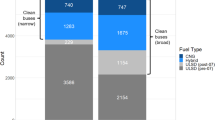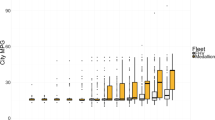Abstract
We investigated commuter exposure to volatile organic compounds in the metropolitan area of Mexico City in 2011 in private car, microbus, bus, metro, metrobus, and trolley bus. A similar survey was conducted in 2002 before initiation of the ProAire2002–2010 program aimed at reducing air pollution. Formaldehyde, acetaldehyde, benzene, toluene, ethylbenzene, m/p-xylene, and o-xylene were sampled while traveling during the morning rush hour in May 2011. Compared with the 2002 survey, in-vehicle concentrations were substantially lower in 2011, except for formaldehyde in microbuses (35% higher than in 2002). The reductions were 17–42% (except microbuses), 25–44%, 41–61%, 43–61%, 71–79%, 80–91%, and 79–93% for formaldehyde, acetaldehyde, benzene, toluene, ethylbenzene, m/p-xylene, and o-xylene, respectively. These reductions are considered to be the outcome of some of the actions in the ProAire2002–2010 program. In some microbuses, use of liquid petroleum gas may have increased in-vehicle formaldehyde concentrations. The reduction in predicted excess cancer incidence of commuters because of ProAire2002–2010 was estimated to be 1.4 cases/yr. In addition, if every microbus commuter changed their transport mode to bus, metro, or metrobus in the future, the estimated excess cancer incidence of commuters could be further decreased from 6.4 to 0.88–2.2 cases/year.
This is a preview of subscription content, access via your institution
Access options
Subscribe to this journal
Receive 6 print issues and online access
$259.00 per year
only $43.17 per issue
Buy this article
- Purchase on Springer Link
- Instant access to full article PDF
Prices may be subject to local taxes which are calculated during checkout


Similar content being viewed by others
References
INEGI (Instituto Nacional de Estadística y Geografía). Official website 2012. http://www.inegi.org.mx/.
Shiohara N, Fernandez A, Jimenez SB, Yanagisawa Y . The commuters’ exposure to volatile chemicals and carcinogenic risk in Mexico City. Atmos Environ 2005; 39: 3481–3489.
Wöhrnschimmel H, Zuk M, Martínez-Villa G, Cerón J, Cárdenas B, Rojas-Bracho L et al. The impact of a Bus Rapid Transit system on commuters’ exposure to benzene, CO, PM2.5 and PM10 in Mexico City. Atmos Environ 2008; 42: 8194–8203.
Wöhrnschimmel H, Magãna M, Stahel WA, Blanco S, Acuña S, Pérez JM et al. Measurements and receptor modeling of volatile organic compounds in Southeastern Mexico City, 2000-2007. Atmos Chem Phys 2010; 10: 9027–9037.
Jo WK, Park KH . Commuter exposure to volatile organic compounds under different driving conditions. Atmos Environ 1999; 33: 409–417.
Lee JW, Jo WK . Actual commuter exposure to methyl-tertiary butyl ether, benzene and toluene while traveling in Korean urban areas. Sci Total Environ 2002; 291: 219–228.
Dor F, Le Moullec Y, Festy B . Exposure of city residents to carbon monoxide and monocyclic aromatic hydrocarbons during commuting trips in the Paris metropolitan area. J Air Waste Manag Ass 1995; 45: 103–110.
Lawryk NJ, Weisel CP . Concentrations of volatile organic compounds in the passenger compartments of automobiles. Environ Sci Technol 1996; 30: 810–816.
Kingham S, Meaton J, Sheard A, Lawrenson O . Assessment of exposure to traffic-related fumes during the journey to work. Transport Res D Tr E 1998; 3: 271–274.
Fernández-Bremáuntz AA, Ashmore MM . Exposure of commuters to carbon monoxide in Mexico City. 1. Measurement of in-vehicle concentrations. Atmos Environ 1995; 29: 525–532.
Molina LT, Molina MJ . Air Quality in the Mexico Megacity, an Integrated Assessment. Kluwer Academic Publishers: Dordrecht. 2002.
CAM (Comisión Ambiental Metropolitana). Programa para Mejorar la Calidad del Aire de la Zona Metropolitana del Valle de México (PROAIRE 2002–2010). Secretaría de Ecología del Gobierno del Estado de México, Secretaría de Medio Ambiente del Distrito Federal, Mexico City 2004.
CAM (Comisión Ambiental Metropolitana) Programa para Mejorar la Calidad del Aire de la Zona Metropolitana del Valle de México (PROAIRE 2011–2020). Secretaría de Ecología del Gobierno del Estado de México, Secretaría de Medio Ambiente del Distrito Federal: Mexico City. 2011.
Álvarez VM, Lara JJF, Moreno AH . Evaluación y Seguimiento del Programa para Mejorar la Calidad del Aire en la Zona Metropolitana del Valle de México 2002–2010. Descripción del PROAIRE; 2010. Universidad Autónoma Metropolitana, Azcapotzalco (in Spanish).
U.S. Environmental Protection Agency (USEPA). Compendium of Methods for the Determination of Toxic Organic Compounds in Ambient Air, 2nd ed. Compendium Method TO-11A, Determination of Formaldehyde in Ambient Air Using Adsorbent Cartridge Followed by High Performance Liquid Chromatography (HPLC) [Active Sampling Methodology]. USEPA Office of Research and Development, Cincinnati, 1999a.
National Institute for Occupational Safety and Health (NIOSH) NIOSH Manual of Analytical Methods 1501 (Issue 3)–Hydrocarbons, Aromatic. Centers for Disease Control and Prevention: Atlanta. 2003.
U.S. Environmental Protection Agency (USEPA). Compendium of methods for the determination of toxic organic compounds in ambient air, 2nd ed. Compendium Method TO-17, Determination of Volatile Organic Compounds in Ambient Air using Active Sampling onto Sorbent Tubes. USEPA Office of Research and Development: Cincinnati. 1999b.
Metro de la Ciudad de Mexico. 2012; Datos de Operacion (in Spanish) http://www.metro.cdmx.gob.mx/operacion/cifrasoperacion.html. Accessed on 30 March 2012.
Metrobús de la Ciudad de Mexico. Demanda de Usuarios (in Spanish); 2012 http://www.metrobus.cdmx.gob.mx/fichas.html. Accessed on 30 March 2012.
U.S. Environmental Protection Agency (USEPA). Integrated Risk Information System (IRIS): Formaldehyde (CASRN 50-00-0) (Carcinogenicity Assessment) 1991a. http://www.epa.gov/iris/subst/0419.htm.
U.S. Environmental Protection Agency (USEPA). Integrated Risk Information System (IRIS): Acetaldehyde (CASRN 75-07-0) (Carcinogenicity Assessment) 1991b. http://www.epa.gov/IRIS/subst/0290.htm.
U.S. Environmental Protection Agency (USEPA) Extrapolation of the Benzene Inhalation Unit Risk Estimate to the Oral Route of Exposure: NCEA-W-0517. USEPA: Washington DC. 1999c.
Liu WT, Ma CM, Liu IJ, Han BC, Chuang HC, Chuang KJ . Effects of commuting mode on air pollution exposure and cardiovascular health among young adults in Taipei, Taiwan. Int J Hyg Environ Health 2015; 218: 319–323.
Schifter I, Diaz L, Rodriguez R, Gonzalez-Macias C . The contribution of evaporative emissions from gasoline vehicles to the volatile organic compound inventory in Mexico City. Environ Monit Assess 2014; 186: 3969–3983.
Bravo H, Sosa R, Sanchez P, Bueno E, Gonzalez L . Concentrations of benzene and toluene in the atmosphere of the southwestern area at the Mexico City Metropolitan Zone. Atmos Environ 2002; 36: 3843–3849.
Ortiz E, Alemon E, Romero D, Arriaga JL, Olaya P, Guzman F et al. Personal exposure to benzene, toluene and xylene in different microenvironments at the Mexico City metropolitan zone. Sci Total Environ 2002; 287: 241–248.
Heeb NV, Forss AM, Bach C, Reimann S, Herzog A, Jackle HW . A comparison of benzene, toluene and C2-benzenes mixing ratios in automotive exhaust and in the suburban atmosphere during the introduction of catalytic converter technology to the Swiss Car Fleet. Atmos Environ 2000; 34: 3103–3116.
Wu X, Apte MG, Maddalena R, Bennett DH . Volatile organic compounds in small- and medium-sized commercial buildings in California. Environ Sci Technol 2011; 45: 9075–9083.
Hodgson AT, Faulkner D, Sullivan DP, DiBartolomeo DL, Russell ML, Fisk WJ . Effect of outside air ventilation rate on volatile organic compound concentrations in a call center. Atmos Environ 2003; 37: 5517–5527.
IMCO (Instituto Mexicano para la Competitividad). Pérdidas millonarias por fallas en lamovilidad urbana; 2012 http://www.elpoderdelconsumidor.org/wp-content/uploads/Perdidas-millonarias_fallas-movilidad-urbana_ZMVM_2012.pdf. Accessed on 2 September 2015.
Espitia AM. Transforming Urban Mobility: A Multidimensional Analysis of the Bus Rapid Transit System of Mexico City. Thesis submitted in partial fulfillment of the Degree of Joint European Master in Environmental Studies (Aalborg, Denmark) 2010. http://projekter.aau.dk/projekter/files/32692275/2010%20EM10%20Adrian%20Martinez.pdf#search='Mexico. “Proair 20022010” accessed on 2 September 2015.
Acknowledgements
This study was conducted as part of the “Joint Research Project on the Formation Mechanism of Ozone, VOCs, and PM2.5 and Proposal of Countermeasure Scenarios” funded by the Japan Science and Technology Agency and Japan International Cooperation Agency under the Science and Technology Research Partnership for Sustainable Development program.
Author information
Authors and Affiliations
Corresponding author
Ethics declarations
Competing interests
The authors declare no conflict of interest.
Additional information
Supplementary Information accompanies the paper on the Journal of Exposure Science and Environmental Epidemiology website
Supplementary information
Rights and permissions
About this article
Cite this article
Shinohara, N., Ángeles, F., Basaldud, R. et al. Reductions in commuter exposure to volatile organic compounds in Mexico City due to the environmental program ProAire2002–2010. J Expo Sci Environ Epidemiol 27, 339–345 (2017). https://doi.org/10.1038/jes.2016.31
Received:
Accepted:
Published:
Issue Date:
DOI: https://doi.org/10.1038/jes.2016.31



